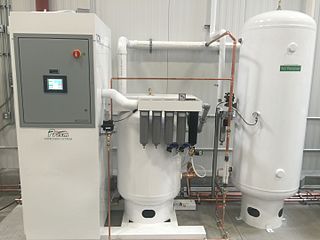
Food preservation includes processes that make food more resistant to microorganism growth and slow the oxidation of fats. This slows down the decomposition and rancidification process. Food preservation may also include processes that inhibit visual deterioration, such as the enzymatic browning reaction in apples after they are cut during food preparation. By preserving food, food waste can be reduced, which is an important way to decrease production costs and increase the efficiency of food systems, improve food security and nutrition and contribute towards environmental sustainability. For instance, it can reduce the environmental impact of food production.
A preservative is a substance or a chemical that is added to products such as food products, beverages, pharmaceutical drugs, paints, biological samples, cosmetics, wood, and many other products to prevent decomposition by microbial growth or by undesirable chemical changes. In general, preservation is implemented in two modes, chemical and physical. Chemical preservation entails adding chemical compounds to the product. Physical preservation entails processes such as refrigeration or drying. Preservative food additives reduce the risk of foodborne infections, decrease microbial spoilage, and preserve fresh attributes and nutritional quality. Some physical techniques for food preservation include dehydration, UV-C radiation, freeze-drying, and refrigeration. Chemical preservation and physical preservation techniques are sometimes combined.

Food drying is a method of food preservation in which food is dried. Drying inhibits the growth of bacteria, yeasts, and mold through the removal of water. Dehydration has been used widely for this purpose since ancient times; the earliest known practice is 12,000 B.C. by inhabitants of the modern Middle East and Asia regions. Water is traditionally removed through evaporation by using methods such as air drying, sun drying, smoking or wind drying, although today electric food dehydrators or freeze-drying can be used to speed the drying process and ensure more consistent results.

Jerky is lean trimmed meat cut into strips and dried (dehydrated) to prevent spoilage. Normally, this drying includes the addition of salt to prevent bacteria growth before the meat has finished the dehydrating process. It originated in the Andes mountains in what is modern day Peru and the word "jerky" derives from the Quechua word ch'arki which means "dried, salted meat". All that is needed to produce basic "jerky" is a low-temperature drying method, and salt to inhibit bacterial growth.

Shelf life is the length of time that a commodity may be stored without becoming unfit for use, consumption, or sale. In other words, it might refer to whether a commodity should no longer be on a pantry shelf, or no longer on a supermarket shelf. It applies to cosmetics, foods and beverages, medical devices, medicines, explosives, pharmaceutical drugs, chemicals, tyres, batteries, and many other perishable items. In some regions, an advisory best before, mandatory use by or freshness date is required on packaged perishable foods. The concept of expiration date is related but legally distinct in some jurisdictions.

Browning is the process of food turning brown due to the chemical reactions that take place within. The process of browning is one of the chemical reactions that take place in food chemistry and represents an interesting research topic regarding health, nutrition, and food technology. Though there are many different ways food chemically changes over time, browning in particular falls into two main categories: enzymatic versus non-enzymatic browning processes.

Oxygen scavengers or oxygen absorbers are added to enclosed packaging to help remove or decrease the level of oxygen in the package. They are used to help maintain product safety and extend shelf life. There are many types of oxygen absorbers available to cover a wide array of applications.

A controlled atmosphere is an agricultural storage method in which the concentrations of oxygen, carbon dioxide and nitrogen, as well as the temperature and humidity of a storage room are regulated. Both dry commodities and fresh fruit and vegetables can be stored in controlled atmospheres.

A packaging gas is used to pack sensitive materials such as food into a modified atmosphere environment. The gas used is usually inert, or of a nature that protects the integrity of the packaged goods, inhibiting unwanted chemical reactions such as food spoilage or oxidation. Some may also serve as a propellant for aerosol sprays like cans of whipped cream. For packaging food, the use of various gases is approved by regulatory organisations.
Potentially Hazardous Food is a term used by food safety organizations to classify foods that require time-temperature control to keep them safe for human consumption. A PHF is a food that:

Vacuum packing is a method of packaging that removes air from the package prior to sealing. This method involves placing items in a plastic film package, removing air from inside and sealing the package. Shrink film is sometimes used to have a tight fit to the contents. The intent of vacuum packing is usually to remove oxygen from the container to extend the shelf life of foods and, with flexible package forms, to reduce the volume of the contents and package.

Food packaging is a packaging system specifically designed for food and represents one of the most important aspects among the processes involved in the food industry, as it provides protection from chemical, biological and physical alterations. The main goal of food packaging is to provide a practical means of protecting and delivering food goods at a reasonable cost while meeting the needs and expectations of both consumers and industries. Additionally, current trends like sustainability, environmental impact reduction, and shelf-life extension have gradually become among the most important aspects in designing a packaging system.

The term fish processing refers to the processes associated with fish and fish products between the time fish are caught or harvested, and the time the final product is delivered to the customer. Although the term refers specifically to fish, in practice it is extended to cover any aquatic organisms harvested for commercial purposes, whether caught in wild fisheries or harvested from aquaculture or fish farming.
Aseptic processing is a processing technique wherein commercially thermally sterilized liquid products are packaged into previously sterilized containers under sterile conditions to produce shelf-stable products that do not need refrigeration. Aseptic processing has almost completely replaced in-container sterilization of liquid foods, including milk, fruit juices and concentrates, cream, yogurt, salad dressing, liquid egg, and ice cream mix. There has been an increasing popularity for foods that contain small discrete particles, such as cottage cheese, baby foods, tomato products, fruit and vegetables, soups, and rice desserts.

Fish preservation is the method of increasing the shelf life of fish and other fish products by applying the principles of different branches of science in order to keep the fish, after it has landed, in a condition wholesome and fit for human consumption. Ancient methods of preserving fish included drying, salting, pickling and smoking. All of these techniques are still used today but the more modern techniques of freezing and canning have taken on a large importance.

Modified atmosphere/modified humidity (MA/MH) packaging is a technology used to preserve the quality of fresh produce so that it can be sold to markets far away from where it is grown, extend the marketing period, and to help suppliers reduce food waste within the cold chain. Commercial examples of MA/MH include sea freight of Galia and cantaloupe melons from Central and South America to Europe and North America ; transport of white asparagus from fields in Peru to markets in Western Europe ; and trucking of cherries from orchards in Turkey to supermarkets in the UK.
The terms active packaging, intelligent packaging, and smart packaging refer to amplified packaging systems used with foods, pharmaceuticals, and several other types of products. They help extend shelf life, monitor freshness, display information on quality, improve safety, and improve convenience.

Biopreservation is the use of natural or controlled microbiota or antimicrobials as a way of preserving food and extending its shelf life. The biopreservation of food, especially utilizing lactic acid bacteria (LAB) that are inhibitory to food spoilage microbes, has been practiced since early ages, at first unconsciously but eventually with an increasingly robust scientific foundation. Beneficial bacteria or the fermentation products produced by these bacteria are used in biopreservation to control spoilage and render pathogens inactive in food. There are a various modes of action through which microorganisms can interfere with the growth of others such as organic acid production, resulting in a reduction of pH and the antimicrobial activity of the un-dissociated acid molecules, a wide variety of small inhibitory molecules including hydrogen peroxide, etc. It is a benign ecological approach which is gaining increasing attention.
Food and biological process engineering is a discipline concerned with applying principles of engineering to the fields of food production and distribution and biology. It is a broad field, with workers fulfilling a variety of roles ranging from design of food processing equipment to genetic modification of organisms. In some respects it is a combined field, drawing from the disciplines of food science and biological engineering to improve the earth's food supply.

Case-ready meat, retail-ready meat, or pre-packaged meat refers to fresh meat that is processed and packaged at a central facility and delivered to the store ready to be put directly into the meat case.















